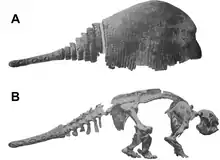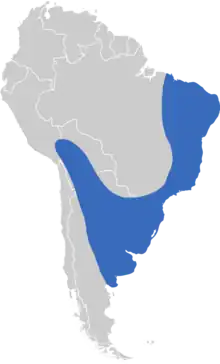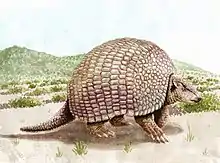| Panochthus | |
|---|---|
 | |
| P. frenzelianus | |
 | |
| Skeleton and shell of Panochthus tuberculatus | |
| Scientific classification | |
| Domain: | Eukaryota |
| Kingdom: | Animalia |
| Phylum: | Chordata |
| Class: | Mammalia |
| Order: | Cingulata |
| Family: | Chlamyphoridae |
| Subfamily: | †Glyptodontinae |
| Genus: | †Panochthus Burmeister, 1866 |
| Type species | |
| †Panochthus tuberculatus Owen, 1845 | |
| Species | |
 | |
| Inferred range of the genus Panochthus based on known localities | |
| Synonyms | |
|
Synonyms of P. tuberculatus
Synonyms of P. greslebini
| |
Panochthus is an extinct genus of glyptodont, which lived in the Gran Chaco-Pampean region of Argentina (Lujan, Yupoí and Agua Blanca Formations), Brazil (Jandaíra Formation), Bolivia (Tarija and Ñuapua Formations), Paraguay and Uruguay (Sopas and Dolores Formations) during the Pleistocene epoch.[1][2][3][4]
It could reach 3 metres (9.8 ft) in length and a weight up to 1,500 kilograms (3,300 lb)[5] the upper skull and the body were protected by hemispherical armor composed of hundreds of rounded scales. The tail, short and wedge-shaped, consisted of small bony bands with small spikes used for defense. Preserved tracheal rings are known from one specimen.[6]
Gallery
 Panochthus vogti skull
Panochthus vogti skull 1878 restoration of P. tuberculatus
1878 restoration of P. tuberculatus
See also
References
- ↑ Panochthus at Fossilworks.org
- ↑ Zurita, Alfredo Eduardo; Zamorano, Martín; Scillato-Yané, Gustavo Juan; Fidel, Sergio; Iriondo, Martín; Gillette, David D. (2017-01-16). "A new species of Panochthus Burmeister (Xenarthra, Cingulata, Glyptodontidae) from the Pleistocene of the Eastern Cordillera, Bolivia". Historical Biology. 29 (8): 1076–1088. Bibcode:2017HBio...29.1076Z. doi:10.1080/08912963.2016.1278443. ISSN 0891-2963. S2CID 91031708.
- ↑ Zurita, Alfredo; Zamorano, Martín; Scillato-Yané, Gustavo; Fidel, Sergio; Iriondo, Martín; Gillette, David (2017-01-16). "A new species of Panochthus Burmeister (Xenarthra, Cingulata, Glyptodontidae) from the Pleistocene of the Eastern Cordillera, Bolivia". Historical Biology. 29 (8): 1076–1088. Bibcode:2017HBio...29.1076Z. doi:10.1080/08912963.2016.1278443. S2CID 91031708.
- ↑ Zamorano, Martín; Mones, Alvaro; Scillato-Yané, Gustavo (2012-04-30). "Redescripción y designación de un neotipo de Panochthus tuberculatus (Owen) (Mammalia, Cingulata, Glyptodontidae)". Revista Brasileira de Paleontologia. 15: 113–122. doi:10.4072/rbp.2012.1.10.
- ↑ (in Spanish) Chicosabordo
- ↑ Zamorano, Martín (2020). "Exceptional preservation of tracheal rings in a glyptodont mammal from the Late Pleistocene of Argentina". Acta Palaeontologica Polonica. 65. doi:10.4202/app.00654.2019. ISSN 0567-7920.
Further reading
- Dinosaur Encyclopedia by Jayne Parsons
- Guimarães de Lima, Fábio Cunha, and Kleberson de Oliveira Porpino. 2018. Ectoparasitism and infections in the exoskeletons of large fossil cingulates. PLoS ONE 13. e0205656. Accessed 2018-10-18.
External links
Wikimedia Commons has media related to Panochthus.
This article is issued from Wikipedia. The text is licensed under Creative Commons - Attribution - Sharealike. Additional terms may apply for the media files.


